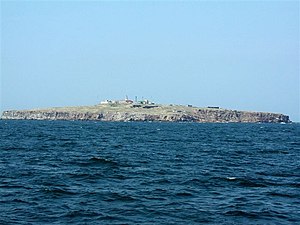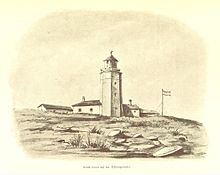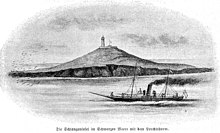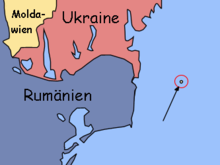Snake island
| Snake island | ||
|---|---|---|
| The Snake Island from the west | ||
| Waters | Black Sea | |
| Geographical location | 45 ° 15 '17 " N , 30 ° 12' 12" E | |
|
|
||
| length | 660 m | |
| width | 660 m | |
| surface | 17 ha | |
| Highest elevation | 41 m | |
| Residents | 30th 176 inhabitants / km² |
|
| main place | Bile | |
| Snake Island sketch | ||
The Snake Island ( Ukrainian Острів Зміїний Ostriw Smijinyj , Romanian Insula Șerpilor , Russian Остров Змеиный Ostrow Smeiny and Greek Leuke “the white”) is one of the few islands and islets in the Black Sea , Ukraine, and belongs to the Kilija district , Odessa Oblast . On the island there is the settlement of Bile with about 30 inhabitants.
description
The island is in front of the Danube Delta and protrudes about 12 nautical miles from the Romanian coast as a 41 m high, white rock from the sea . It has a diameter of about 600 m, an area of 17 hectares and a coastline of 4 km.
The information about the facilities built on the rocky island is contradictory, as it was previously inaccessible as a military restricted area . There is said to be a 23 m high lighthouse with a range of 19 nautical miles, built after the Second World War . In addition, there are two berths for ships with large and medium tonnage and a Ukrainian border station. The Soviet Black Sea Fleet is said to have built ammunition and fuel depots, radar systems and missile positions.
etymology
In ancient times the island is said to have been inhabited only by sea birds and snakes , the latter giving it its later name. The island was also called Leuke (Λευκή, Greek), the white, because from a distance it resembles the white limestone of the Dobruja .
The Greeks named the island Fidonisi ( Greek "snake island ") during the occupation by the Turks .
Greek mythology
The legendary story Heroikos , written in the 2nd century by the historian Philostratos of Lemnos , reports about the island . In Greek mythology it was considered the "island of the happy" because troubled souls found their eternal rest on it. The most prominent was the soul of the Trojan War fallen Achilles , son of the sea goddess Thetis . According to legend, Poseidon is said to have raised him from the depths and given him a final resting place there. The legend reports that a temple and a statue of Achilles existed on the island . Greek sailors would have docked on the island to offer precious gifts such as rings and vessels. Corresponding finds are now in a museum in Odessa .
Among the numerous hypotheses about the location of Plato's Atlantis, sunk in the sea , a more recent thesis describes the Snake Island as the last remnant of this island continent.
Description of the island in antiquity
- White cliffs rise from the sea
- partly with overhanging walls,
- no flat,
- no human sound, neither on the shore nor in the lonely valley gorges,
- only flocks of white birds hover around the cliffs.
- Whoever sets foot on the island never dares to spend the night on it. When you have visited the temple and the tomb of Achilles and viewed the votive gifts placed by previous visitors, you board the ship again in the evening.
history
Middle Ages and Modern Times
The rule over the uninhabited and strategically strategically located island was always linked to the political conditions on the nearby mainland.
In the 14th and 15th centuries, the island was under the sovereignty of the Wallachian prince Mircea cel Bătrân , who ruled over the entire region ( Dobruja , mouth of the Danube , southern Bessarabia ). When the Black Sea became a Turkish inland sea in the 16th century , the Snake Island , along with the Wallachian principality, fell to the Sublime Porte in Istanbul for centuries . The name of the island was now Jilan Adassi .
With the collapse of the Ottoman Empire and the Russian expansion to the south in the 19th century, the military importance of the tiny sea island increased. In 1788, during the 7th Russian Turkish War , the battle of Fidonisi between the Russian and Ottoman fleets took place near the island . After the 9th Russian Turkish War , Russia came into their possession for a short time when, in the Peace of Adrianople in 1829, it forced the Ottoman Empire to cede the mouth of the Danube and with it Snake Island. In 1854 the fleets of Great Britain, France and Sardinia-Piedmont met in front of the island to go together in the Crimean War and call at Sevastopol . After the Russian defeat, tsarist troops remained on the island, as they were not mentioned in the Peace of Paris in 1856. A withdrawal took place only in 1857 after the threat of shelling Russian ports by the British fleet.
In the 11th Russian Turkish War of 1877/78, the Russian Empire again forced Turkey to cede the Danube Delta and the Snake Island, but in favor of the Romanian Kingdom , as part of the Dobruja .
In 1856 the European Danube Commission was founded, which initiated the development of the Danube as a European waterway. To mark the navigable passages in the Danube Delta and on the Black Sea coast, lighthouses and sea marks were installed. The Snake Island lighthouse was maintained in 1891 by five lighthouse keepers of Turkish origin and three Romanian marines and was overseen by the port commander of the city of Sulina . The lighthouse keepers were paid by a fund of the Danube Commission. At this time, the Austrian hunting and travel writer Leo Freiherr von Kalbermatten , coming from Sulina, visited the island, he described his impressions of the animal world:
- In the east and south-east of the island I discovered breeding grounds for herring gulls (Larus argentatus). ... There was a colossal number of snakes at the breeding ground for the gulls; this genus of snakes ( Tesselatus ) occurs throughout Europe, is glossy black in color and about 3 to 4 feet long. ... the former cistern at the breeding grounds was also teeming with snakes, but otherwise there were no snakes on the whole island or on the beach. ...
During the First World War , the island was briefly occupied by German marines on June 25, 1917: A landing party from the cruiser Breslau (Turkish Midilli) occupied the island for two hours after the cruiser had destroyed the radio station on the island by artillery fire. The squad took several prisoners and captured a pig and several mutton .
present
The Snake Island belonged to Romania (city of Sulina ) until 1948, when it came into the possession of the Soviet Union because of the Romanian politician Ana Pauker, who was loyal to Moscow . Snake Island was handed over to the Soviet Union in a secret protocol dated May 23, 1948, which the Romanian public did not know about for decades. In 1975 the then Romanian President Nicolae Ceaușescu asked for an account of how it was possible that this island came into Soviet possession. After the collapse of the Soviet Union , Ukraine and Romania negotiated the fate of the island in Kiev for several years. In 1991 the mainland border between the two countries was determined, but this was controversial until 2003. After NATO urged Romania to better secure its national borders, the Ukrainian-Romanian border treaty was signed on June 17, 2003 in Czernowitz after a ten-year dispute, which now defines the course of the border. In return, the Ukrainian government promised not to station any offensive weapons on the island.
An important point of contention was, among other things, the demarcation through the division of the Black Sea continental shelf, in which large oil and natural gas deposits are suspected. The dispute over the demarcation of the continental shelf was resolved on February 3, 2009 by the International Court of Justice - Romania receives about 79%, Ukraine 21% of the controversial continental shelf.
Island visit
In 1998, the German circumnavigator Rollo Gebhard headed for the small rocky island on a sailing tour through the Black Sea . His boat was the first foreign ship that was allowed to visit the island, which was developed as a military base and observation station. The short stay served the scientific exploration of the fauna and flora . The rock is reminiscent of that of Heligoland , which is 10 times larger , but without a protected mooring or harbor . The landing was done with the rubber dinghy between the rocks and by climbing a steep wall. The visit was a sensation for the coast guard soldiers because of the monotonous service. The island commander even led the visitors to the barracks .
literature
- Leo Freiherr von Kalbermatten: Swamp life and hunting. From Vienna to Batum in Asia Minor. Hartleben, Vienna a. a. 1891, pp. 151-159.
- Hannes Hofbauer , Viorel Roman: Bukowina, Bessarabia, Moldova. Forgotten land between Western Europe, Russia and Turkey. Promedia, Vienna 1993, ISBN 3-900478-71-6 (2nd, improved and expanded edition, ibid 1997, ISBN 3-85371-126-X ).
Individual evidence
- ^ Evenimentul Zilei, September 4, 2008 , accessed April 29, 2011.
- ^ Judgment of the International Court of Justice of February 3, 2009. ( Memento of the original of February 5, 2009 in the Internet Archive ) Info: The archive link has been inserted automatically and has not yet been checked. Please check the original and archive link according to the instructions and then remove this notice. (PDF; 1 MB)
Web links
- Romania wins legal battle over Snake Island , Siebenbürger Zeitung, February 18, 2009
- Border dispute with Ukraine Romania moves to the International Court of Justice, SZ.de , May 11, 2010
- Long-term consequences of the "Cold War" - Snake Island in the Black Sea, euronews , February 3, 2009
- Snake Island, hellenica.de
- Ukraine increases troop presence on Snake Island . Ukrinform, February 15, 2016
- The unstable Romania-Ukraine-Moldova triangle , Backyard Safari, June 17, 2011
- International Court of Justice in The Hague ends border disputes between Romania and Ukraine in the Black Sea , Ukraine-Nachrichten, February 4, 2009
- Court draws new maritime border between Romania and Ukraine , DW , February 5, 2009
- Energy dispute: The island is just a rock ( memento from April 28, 2019 in the Internet Archive ), Die Presse , February 3, 2009






